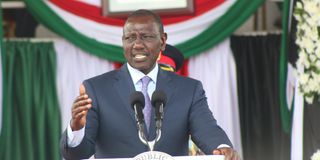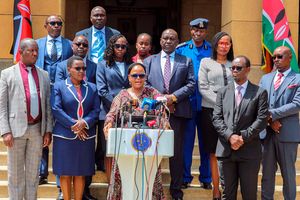
President William Ruto speaks during the Kenya Forest Service (KFS) passout ceremony in Gilgil, Nakuru County on October 28, 2024.
President William Ruto’s promise to develop an abduction response plan remains just that despite having recognised enforced disappearances among threats to national security in his annual report on the state of national security before Parliament.
The delays in establishing the abduction and kidnapping response plan could be the reason cases of enforced disappearances of government critics in the country have increased in the recent past.
This is notwithstanding that kidnapping and abduction are serious offences in the Penal Code “hence the recent increase in such crimes is of grave concern to the government”.
“Kidnappings and abductions in Kenya have become a security concern in the recent past and the victims are not only men but also women and children, including foreign nationals,” President Ruto said during his State of the Nation address on November 21, 2024.
As at December 27, 2024, the Kenya National Commission on Human Rights (KNCHR), a state agency, revealed that 82 people had been reported abducted since the protests over the high cost of living and bad governance started in June 2024.
Whereabouts of 20 abductees
According to KNCHR, the whereabouts of more than 20 abductees remain unknown, subjecting their families to despair even as the police distanced themselves from the disappearances.
The annual report on the state of security shows that kidnappings in the country between September 2023 and August 2024, had increased by 16 compared to the 36 cases reported between September 2022 and August 2023.
The document shows that with 14 cases, the Coast region led in the number of abductions, followed by Rift Valley (10), Central (eight), Nyanza (seven), Eastern (six), Nairobi (five) and North Eastern (two), with Western region recording no cases.
Although the report claims that the government had enhanced public awareness campaigns and collaboration with mobile telephone service providers “to assist with the investigations”, many victims of abduction are yet to be reunited with their families.
Other than closely working with the mobile telephone service providers, the government claims to have undertaken measures that include freezing of bank accounts of suspects “awaiting conclusion of their court cases.”
When he appeared before the Administration and Internal Affairs Committee of the National Assembly, Inspector-General of Police Douglas Kanja reported 57 cases of kidnapping and abduction across the country since June 2024, of which 22 victims had by the time been reunited with their families.
The IG reported six deaths while noting that the whereabouts of 29 abductees remain unknown. He exonerated police from any involvement in the enforced disappearances.
“The arrest of protesters captured on surveillance cameras committing offences led to public outcry and propaganda that police were engaged in abductions and kidnapping,” Mr Kanja told the committee.
“The police were performing their duties of investigating crimes committed in the name of demonstrations by tracing those captured on CCTV committing crimes,” he added.
Incriminating dossier
But even as the police boss spoke, an incriminating dossier submitted to Parliament by KNCHR revealed that all the deaths and torture cases it investigated emanating from the Gen Z-led protests had the hallmarks of security agents.
“We wish to remind the police of its role in securing Kenyans from such violent acts, noting that these abductions are happening in broad daylight but still there are no arrests,” the KNCHR document states.
The government report on security lists providing security agencies with modern equipment, expedited investigations “into these cases whenever they occur” and fast-tracking development of legislation and ratification of the International Convention for the Protection of All Persons Against Enforced Disappearance as key to ending the menace.
However, it appears to be a case of a lot of talk and little or no tangible action on the ground as families of the victims continue to agonise over their loved ones.
Other than the kidnappings, the report also lists terror threats, organised criminal gangs, violent protests, cybercrime, resource-based conflicts and transnational organised crime as threats to national security.
It also lists corruption, unemployment among the youth, rising cost of living, financial and economic crimes and civil unrest.









